Morning Routines for ADHD & Neurodivergent Children
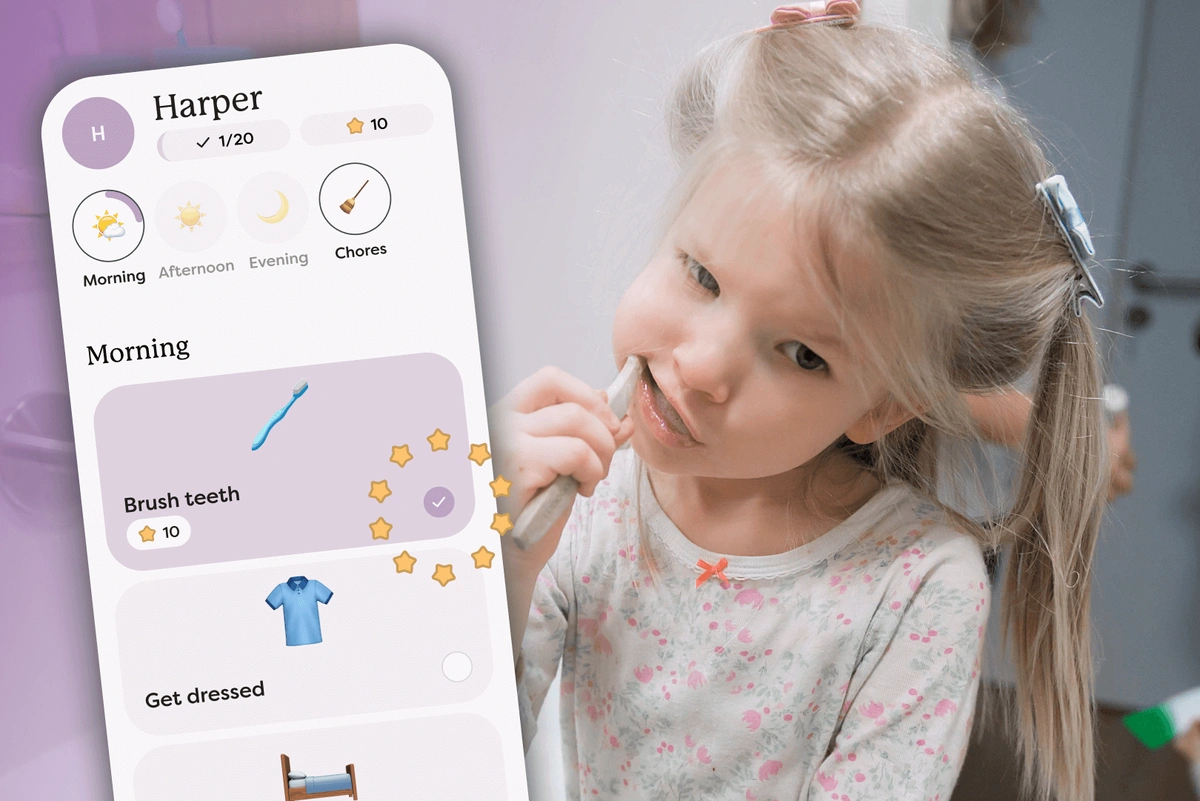
Why Neurodivergent Kids Struggle with Mornings
If mornings at your house feel like a tornado of mismatched socks, meltdowns, and a race against the clock, you’re not alone. For many neurodivergent kids, mornings present a perfect storm of sensory input, executive function demands, and emotional regulation needs. [Meltzer, L. (2010). Executive Function in Education: From Theory to Practice. Guilford Press.]
Whether your child is autistic, has ADHD, anxiety, a developmental disability, or sensory processing differences, a predictable, flexible morning routine can make the start of the day more manageable.
For many neurodivergent kids, the transition from sleep to activity is jarring. Add in clothing textures, bright lights, unexpected sounds, and multiple instructions in a row, and it’s no wonder mornings can feel overwhelming. [Dunn, W. (2007). Supporting children to participate successfully in everyday life by using sensory processing knowledge. Infants & Young Children, 20(2), 84–101.]
Here’s What Helps
Research shows that consistent routines help reduce stress, build confidence, and support task initiation (Wong et al., 2020). For neurodivergent kids, routines offer predictability and a sense of safety, which is essential for emotional regulation and building independence.
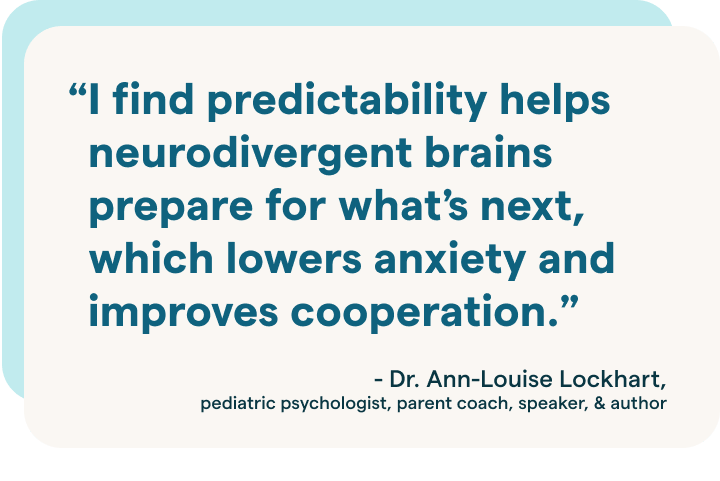
“I find predictability helps neurodivergent brains prepare for what’s next, which lowers anxiety and improves cooperation. For neurodivergent kids, especially those diagnosed with ADHD, autism, or anxiety, structure isn’t about control; it’s about safety. It’s like giving them a roadmap instead of tossing them into rush hour without a GPS.” - Dr. Ann-Louise Lockhart, pediatric psychologist, parent coach, speaker, and author.
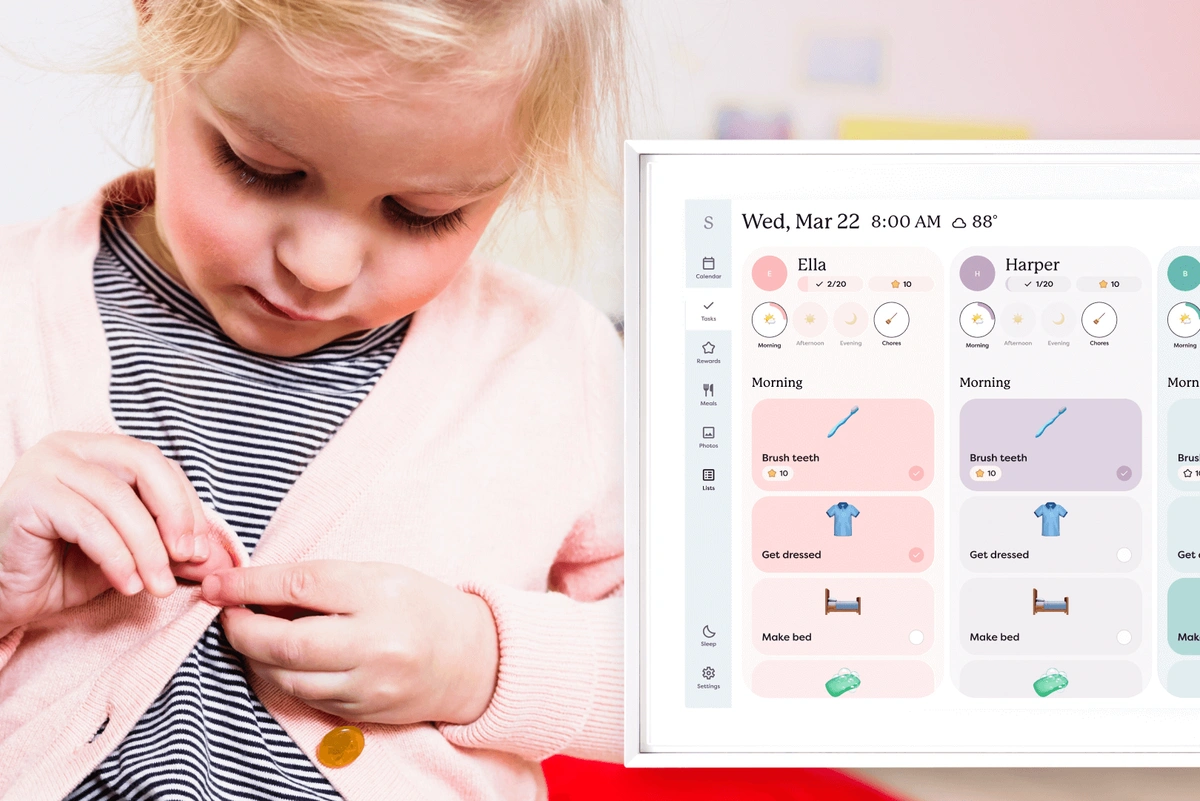
What Makes a Neurodivergent-Friendly Morning Routine?
Forget rigid schedules or Pinterest-perfect charts. A supportive morning routine is one that meets your child where they are. That means designing routines that:
-
reduce cognitive load
-
minimize sensory overwhelm
-
and allow space for autonomy, even in small ways
Here’s what that can look like in practice:
-
Predictable steps in the same order each day: Neurodivergent kids often find comfort in repetition. The order matters more than the time. Even if you’re running late, sticking to the same sequence helps reduce anxiety and build a sense of internal rhythm.
-
Visuals instead of verbal instructions: Verbal reminders can overwhelm or get lost in the noise. Try routine cards with pictures, a checklist on the fridge, or a Skylight Calendar set to show the day’s steps with icons your child can recognize. [Effects of Visual Schedules on Behavior, NCBI, 2009]
-
Sensory-friendly environments: Lighting, sound, textures all matter. Maybe your child prefers soft lighting while waking up, looser clothes without tags, or familiar smells in the kitchen. When the environment feels safe to their body, it’s easier for their brain to focus.
-
Built-in time for regulation: This could be five minutes of jumping on the trampoline, a weighted blanket snuggle, slow stretches, or a favorite song on repeat. These moments aren’t “extra,” they’re necessary tools that help your child transition from rest to readiness.
-
Fewer transitions and clearer boundaries: Transitions can be hard, especially when your child isn’t done with the current activity or doesn’t know what’s next. Try “first/then” language (“First breakfast, then backpack check”) and consider using fewer steps with more space between them.
-
Shared control, not constant correction: Kids feel more invested when they get a say. That might mean choosing which task to start with, picking between two breakfast options, or tapping the calendar icon to move on. When the routine is something they do, not something done to them, it’s more likely to stick.
Skylight tip: Use a visual calendar or checklist your child can interact with. This builds autonomy and reduces stress.
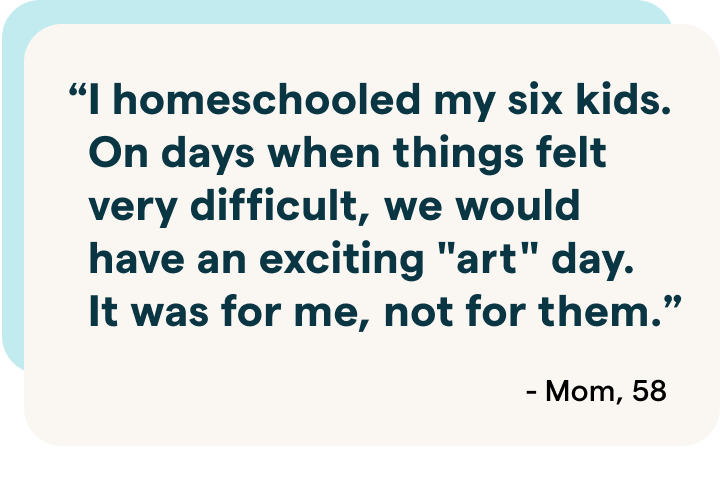
“I homeschooled my six kids. On days when things felt very difficult, we would have an exciting "art" day. It was for me, not for them.” - Mom, 58
Sample Morning Routine for Neurodivergent & ADHD Kids
This sample is flexible, so you can adapt it to your child’s age, sensory needs, and pace. This is an ideal version of the flow, but not every day will be perfect. There will be spills, skipped steps, and “I need five minutes to myself locked in a bathroom,” moments. The goal isn’t a flawless routine, it’s creating something reliable and comforting enough to return to.
6:30–6:50 AM: Gentle Wake-Up & Regulation
Use soft lights, favorite music, or a weighted blanket. Some kids may need movement (jumping, stretching), while others need quiet time to orient.
6:50–7:10 AM: Get Dressed
Offer two outfit choices. Use photos or icons to represent each step. Pre-check for scratchy seams or uncomfortable tags.
7:10–7:30 AM: Breakfast
Stick with 1–2 favorite foods on rotation. Try using consistent plates/cups for comfort. Avoid rushing. [If you can, this should acknowledge that this is a luxury, if you can not rush]
7:30–7:45 AM: Hygiene Time
Use a visual checklist for teeth, face, hair, medication. Consider a reward system (like a sticker chart or favorite song) after completion.
7:45–8:00 AM: Bag Check & Transition
Review a visual list together: backpack, water bottle, comfort item, device, snack. Allow time for regulation before heading out.
“Transitions are hard for kids with special needs. Being able to see how the day is mapped out is especially helpful and reduces anxiety.” - Mom, 44
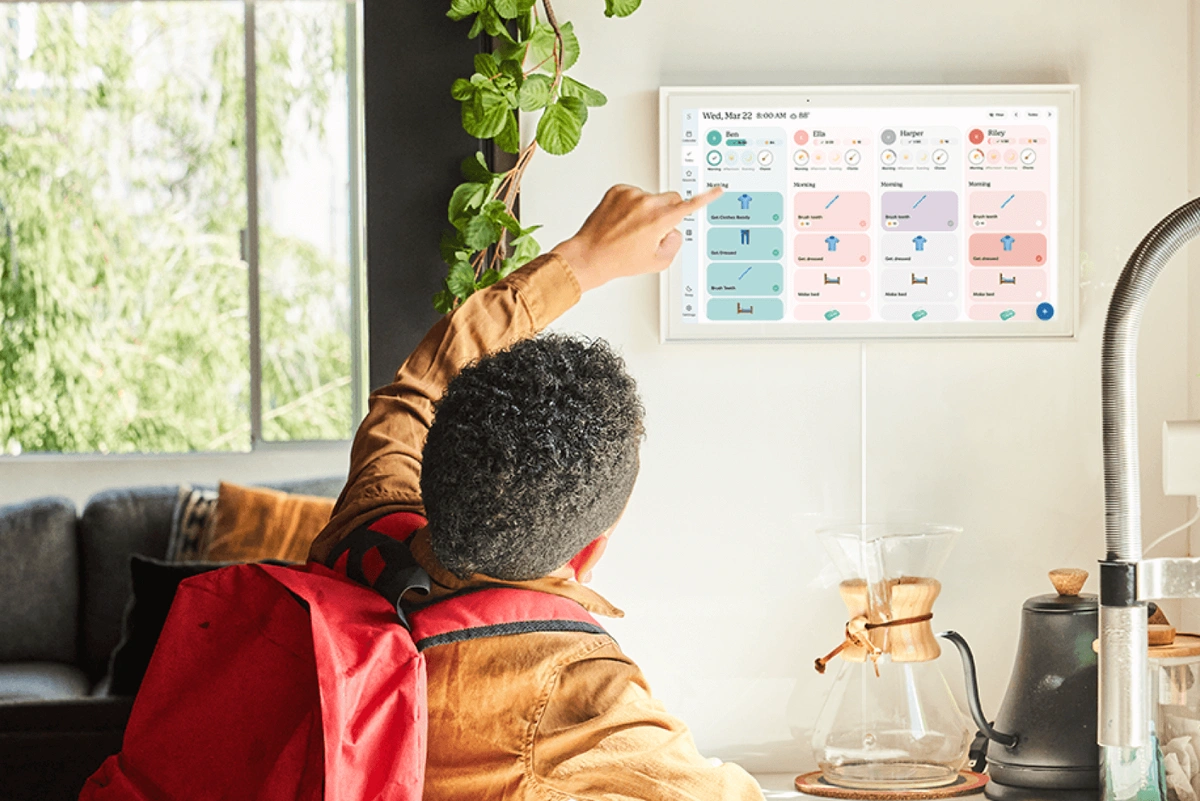
Tips for Supporting Neurodivergent Kids in the Morning
Creating a consistent morning routine for neurodivergent children can make a major difference in reducing overwhelm and improving flow. If you’re starting from scratch or trying to troubleshoot what’s not working, here are a few foundational strategies:
-
Use consistent sequencing: Same order, every day, even if timing shifts.
-
Allow for sensory needs: Build in movement breaks, quiet corners, and preferred textures.
-
Reduce verbal prompts: Show, don’t tell. Use icons, images, or gestures.
-
Break tasks into smaller steps: Instead of “get dressed,” break it into “put on shirt,” “put on pants,” and so on. Visual checklists help kids see progress.
-
Practice during calm times: Introduce new routines in the evening or on weekends, when pressure is lower.
-
Offer control through choice: “Do you want to brush teeth or get dressed first?” helps shift resistance into ownership.
Skylight tip: Customize your Skylight Calendar with icons, colors, and daily affirmations that reflect your child’s pace and personality.
Customizing for Different Needs
Every neurodivergent child is different. Some need more sensory input; others need less. Some thrive on humor and movement; others need softness and stillness. Here are a few customizations that might help:
-
Use a checklist with textures (velcro, buttons, flaps)
-
Try a “first/then” board for sequencing tasks
-
Create a movement-based routine with dance breaks or yoga stretches
-
Use audio or video cues, like short recorded messages or routine songs
-
Let them co-create the routine by taking photos of each step
Skylight tip: If you’re building a new routine, start with one step at a time. You can add more as it becomes familiar.
FAQs: Morning Routines for Neurodivergent Kids
Q: What time should I wake my child up?
A: Earlier than you think. Many neurodivergent kids need extra transition time. Give a longer runway and keep the wake-up routine consistent. “For neurodivergent kids, especially those diagnosed with ADHD, autism, or anxiety, structure isn’t about control; it’s about safety. It’s like giving them a roadmap instead of tossing them into rush hour without a GPS.” - Dr. Lockhart
Q: My child resists every step — what can I do?
A: Start by removing friction: Is the task too big? Too fast? Too loud? Use visuals, reduce choices, and validate their feelings while keeping the structure.
Q: How do I encourage independence?
A: Give your child tools — not just commands. Use pictures, timers, and hands-on choices to let them guide the process within a clear framework.
Q: What if we have meltdowns every morning?
A: You’re not alone. Meltdowns aren’t failures — they’re communication. Stay calm, adjust expectations, and focus on co-regulation. Consistency over time helps reduce the frequency.
Special thanks to…
-
Dr. Ann-Louise Lockhart is a pediatric psychologist, parent coach, speaker, and author who helps overwhelmed parents raise confident, emotionally healthy kids and teens. As the founder of A New Day Pediatric Psychology, she empowers families to move from chaos to connection using practical tools rooted in clinical expertise and real-life parenting. She is the author of an upcoming book launching October 28, 2025 titled, Love the Teen You Have: A Practical Guide to Transforming Conflict Into Connection. She has been featured in The New York Times, Parents, HuffPost, and on The Today Show. Her dynamic, relatable style has made her a trusted voice for parents nationwide.
-
The Skylight Parent Panel and the families navigating mornings with care, patience, and creativity.
